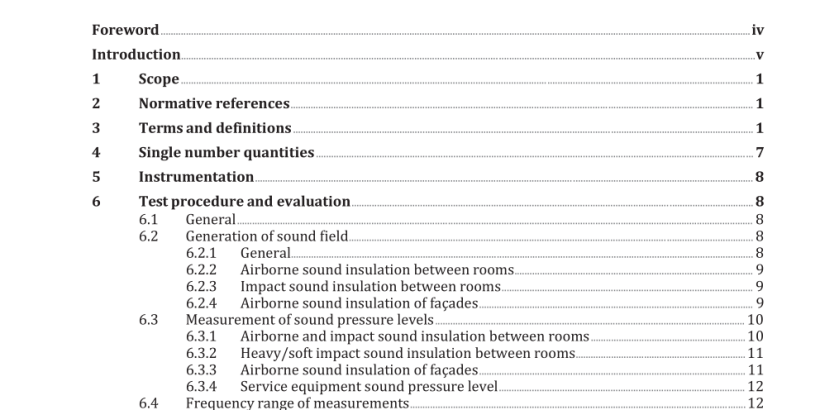ISO 10052:2021 pdf download – Acoustics — Field measurements of airborne and impact sound insulation and of service equipment sound — Survey method.
1 Scope This document specifies field survey methods for measuring a) airborne sound insulation between rooms, b) impact sound insulation of floors, c) airborne sound insulation of façades, and d) sound pressure levels in rooms caused by service equipment. The methods described in this document are applicable for measurements in rooms of dwellings or in rooms of comparable size with a maximum of 150 m . For airborne sound insulation, impact sound insulation and façade sound insulation the method gives values which are (octave band) frequency dependent. They can be converted into a single number characterising the acoustical performances by application of ISO 717-1 and ISO 717-2. For heavy/soft impact sound insulation, the results also are given as A-weighted maximum impact sound pressure level. For service equipment sound the results are given directly in A – or C -weighted sound pressure levels.
2 Normative references The following documents are referred to in the text in such a way that some or all of their content constitutes requirements of this document. For dated references, only the edition cited applies. For undated references, the latest edition of the referenced document (including any amendments) applies. ISO 10140-5:2021, Acoustics — Laboratory measurement of sound insulation of building elements — Part 5: Requirements for test facilities and equipment ISO 16283-2:2020, Acoustics — Field measurement of sound insulation in buildings and of building elements — Part 2: Impact sound insulation IEC 61260, Electroacoustics — Octave-band and fractional-octave-band filters IEC 61672-1, Electroacoustics — Sound level meters — Part 1: Specifications
3.10 heavy/soft impact source standard impact sound source to measure heavy/soft impact sound in dwellings such as a child running and jumping or an adult walking Note 1 to entry: For more information see ISO 10140-5 and ISO 16283-2. 3.11 maximum impact sound pressure level L i,Fmax impact sound pressure level measured by Fast time-weighting at receiving points when the heavy/soft impact source (3.10) impacts the floor Note 1 to entry: This quantity is expressed in decibels. 3.12 average sound pressure level L 1,s <on a test surface> ten times the logarithm to the base 10 of the ratio of the surface and time average of the sound pressure squared to the square of the reference sound pressure, the surface average being taken over the entire test surface including reflecting effects from the test specimen and façade Note 1 to entry: It is expressed in decibels. 3.13 façade level difference D 2m difference between the outdoor sound pressure level 2 m in front of the façade, L 1;2m , and the space and time averaged sound pressure level, L 2 , in the receiving room Note 1 to entry: It is expressed in decibels as: D 2m = L 1,2m – L 2 It is also possible to measure in the plane of the façade. In this case the denotation is L 1,s instead of L 1,2m . If road traffic sound has been used as sound source the notation is D tr,2m D ls,2m and is expressed in decibels.
5 Instrumentation The measuring service equipment shall comply with the requirements of Clause 6 . The sound source for measuring sound insulation between rooms shall be as omnidirectional as practicable. In façade measurement, the opening angle shall cover the whole façade. The directivity of the sound source and the distance to the façade shall be such that the variations between pressure levels measured in front of the façade, for each frequency band of interest, are less than 5 dB. The tapping machine shall comply with the requirements given in ISO 10140-5:2021, Annex E and ISO 16283-2:2020, Annex A. The heavy/soft impact source – rubber ball shall comply with the requirements given in ISO 10140-5:2021, Annex F and ISO 16283-2:2020, Annex A. The accuracy of the sound pressure level measurement equipment shall comply with the requirements of accuracy classes 1 or 2 defined in IEC 61672-1. The complete measuring system including the microphone shall be adjusted before each measurement to enable absolute values of sound pressure levels to be obtained. For all measurements diffuse field microphones are required. For sound level meters with free field microphones corrections for accounting the diffuse sound field shall be applied. Filters shall comply with the requirements defined in IEC 61260. NOTE For pattern evaluation (type testing) and regular verification tests recommended procedures for sound level meters are given in OIML R58 and R88.
